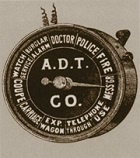ADT’s Digital Transformation – 140 Years in the Making

How a telegraph company survived a digital revolution and became a leader in the smart home industry.
History of Home Security
In the wake of World War 1, the crime rate within the United States began to rise and brought both, personal and property, safety and security to the forefront of concerns for the American people.1 No company was better prepared to suit the needs of the young country than The American District Telegraph Company (ADT). Although founded as a telegraph company in 1874, ADT welcomed change with open arms as the technological advancement of the call box came to the scene. Through the use of the call box, an ADT watchman, on behalf of a customer, could transmit a specific signal to a district office alerting ADT of a particular need of the customer. These early recipients included police, fire departments, doctors, and coach drivers. With 24-hour alarm monitoring services ADT provided the peace of mind that in emergency situations the proper authorities would be promptly notified. ADT continued to innovate its technology through the 1940s with the development of the Teletherm Automatic Fire Detection System, Telewave Automatic Intrusion System, and Ultrasonic Burglar Alarm.2
ADT continued to stay at the leading edge of security and innovation of technology through the turn of the century. Over time, the concern of home safety and security have not faded. In fact, according to the FBI, the United States leads the world in the number of burglaries with one burglary occurring every 15 seconds.3 This continued concern has led to further advancements of technology and connectivity within the household. Ultimately, leading to the formation of the new “Smart Home” Industry and expansion of technology for home automation as solutions for security and sustainability.4 ADT saw an opportunity to pivot into the Smart Home market given their long history as a security provider. With the release of the ADT Safewatch iCenter in 2001, ADT became the first security company to offer a web-enabled home security system and established its presence as the first mover in the digital transformation. Again innovation struck with the release of ADT Pulse Interactive Solutions in 2010. ADT Pulse provided customers with any compatible smartphone or laptop real time remote access and control of their home security system and other applications within the ADT catalogue.2
ADT Today
Today, ADT views themselves as a large player in the new and fast growing Smart Home industry with many new competitors entering the market.5 The following is a list of features from the ADT portfolio offered to customers via the ADT Pulse mobile app:6
- Remote arming and disarming of your security system
- Video surveillance with live streaming and motion detection and alerting
- Burglary monitoring with window and door sensors
- Fire and Smoke monitoring with advanced smoke and heat sensors
- Carbon monoxide monitoring with emergency personnel notification
- Flood monitoring with emergency personnel notification
- Remote locking and unlocking of doors and access points
- Remote garage door controls
- Video doorbell surveillance by Ring
- Remote temperature control by Nest (oddly resembles the original ADT call box above)
- Remote lighting control
- Energy management
The Future of ADT
With 140 plus years of history, ADT has been successful because of its willingness to change and adapt in order to meet the changing demands of a more technologically advanced customer. I believe the challenge for ADT will be to continue this flexibility while being able to adapt and innovate at a faster pace given the speed of advancing technology. ADT currently partners with companies such as Ring and Nest to provide certain features to its customers. My fear is that eventually the consumers will realize no value add by ADT for these types of products and eventually cut ADT’s Pulse app out as the middleman. To combat this trend, ADT must develop new technology to remain relevant in the eye of the consumer. One untapped area of opportunity they have yet to explore is the automobile. Cars hitting the market today have network capabilities much like a house. ADT can leverage their home security knowledge and applications to provide remote vehicle security and features. With continued innovation ADT can realize success for the next 140 years.
Word Count: 684
Endnotes:
1 “The History of Home Security,” Home Security – Alarm.org website, www.alarm.org/HomeSafety/EvolutionofHomeSecurity, accessed November 2016.
2 “ADT Security – Company History,” About ADT – ADT website, www.adt.com/about-adt/history, accessed November 2016.
3 “The Hard Facts on Home Security,” Home Security – Alarm.org website, www.alarm.org/HomeSafety/HardFacts, accessed November 2016.
4 Hendricks, Drew. “The History of Smart Homes,” (April 22, 2014) Internet of Things Evolution World website, www.iotevolutionworld.com/m2m/articles/376816-history-smart-homes, accessed November 2016.
5 “2015 Annual Report,” Annual Reports – ADT Investors website, investors.adt.com, accessed November 2016.
6 “Home Security and Automation System Features,” Features – ADT website, www.adt.com/features, accessed November 2016.
Image Sources:
2 “ADT Security – Company History,” About ADT – ADT website, www.adt.com/about-adt/history, accessed November 2016.
6 “Home Security and Automation System Features,” Features – ADT website, www.adt.com/features, accessed November 2016.





Is there any evidence of these smart homes being hacked? I could envision some kid developing a trojan horse virus that effects home security systems and all of a sudden my garage door is going up and down on its own. That would really suck.
Also what keeps a burglar from just going to the electric panel on the house and cutting off all the power to the house and home security system? Or jerking the at&t box off the house. Then all of the smart house isn’t so smart.
Garet – It is amazing that ADT’s value proposition has been pretty much unchanged since the 1940s. Do you think the company will undergo any major near-term strategic shifts as a result of its new ownership structure?
In February 2016, the Company announced it would be acquired by the private equity firm Apollo Management for ~$7 billion [1]. Apollo stated that it intends to merge ADT with its existing portfolio companies in the security services space, Protection 1 and ASG. Given that these three companies will form the largest home security services firm in the United States, I could see ADT becoming less likely to innovate in the future. This is because the new pro forma entity will have such a strong competitive position that it won’t face as much pressure to find new ways to win subscribers. I could also see the merged company’s massive free cash flow profile de-incentivizing the new ownership team to make any radical changes. This is because they will be able to use the strong recurring-monthly-revenues to take massive dividends and realize immediate returns. What are your thoughts?
1. http://www.wsj.com/articles/apollo-adt-deal-moves-forward-after-go-shop-period-expires-1459168605
To quote Saint Thomas Aquinas, “Our homes are our castles and ADT is the moat that allows us to sleep at night.”
Your blog beautifully capture that the traditional “home” is expanding. We no longer need to only monitor the walls we sleep behind, we now need to monitor our cars too. What company is better suited to help us do this than ADT? It seems that ADT is picking up the gauntlet and trying to make our lives more secure – thank goodness for that.
While it makes total sense to me that ADT step into the car security market, I’m not as convinced that “home automation” is in their wheelhouse. The “smart home” industry seems to be massive and I’m not sure that ADT is equipped to handle this new and exciting technological frontier. If they can’t make it work with Nest and Ring, who can they make it work with?
Awesome post. ADT was in the internet of things before the internet existed.
It’ll be interesting to see the future of smart home play out: my post discusses a bit about how Roombas could be linked with fire alarms (and Amazon’s Echo) to serve as a roving fire detector. ADT could defend its position as the home security leader by making it more “linkable” with other IoT items: think Roomba for fire/theft detection, continued integration with Nest for surveillance, Amazon Echo for activation of counter-burglar devices a la “Home Alone”. As long as they stay ahead of the game, they could be in a stellar position to be a key centerpiece in the IoT.